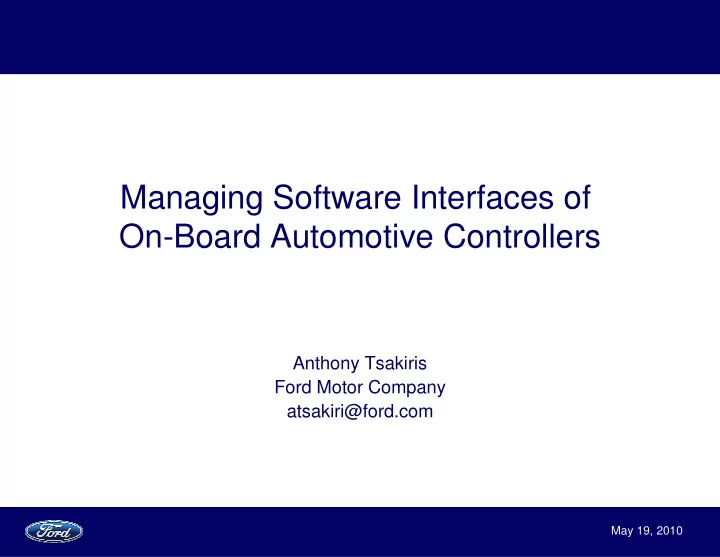

Managing Software Interfaces of On-Board Automotive Controllers Anthony Tsakiris Ford Motor Company atsakiri@ford.com May 19, 2010
Introduction Today’s cars rely heavily on software-intensive electronic controllers that share information. A typical Ford vehicle has 20 controllers. Our high-end vehicles have about 40 controllers. Vehicle Network Increasingly, controllers must cooperate to deliver functions none can provide alone. May 19, 2010
Hybrid Electric Power Pack High Voltage Battery + Controller Engine + Controller Motor + Generator + Gear Set + Controller May 19, 2010
Business Goals • Avoid duplication of engineering work • Easily deploy new features and technologies • Be quicker to market • Reduce product and development cost May 19, 2010
Scenario 1 Offer different power packs in a single vehicle May 19, 2010
Scenario 2 Reuse a power pack in different vehicles May 19, 2010
The Problem We tried to reuse the hybrid electric power pack of a North American SUV in a European sedan that original had a conventional power pack. (scenario 2) • Many unanticipated interface mismatches • Lots of re-engineering • Slow progress • Project eventually cancelled Two big causes: • Interface variations • Organizational constraints Square peg, round hole! May 19, 2010
Cause 1 - Variation Optional features across large product line FOCUS COUPE FUSION MUSTANG TAURUS FUSION HYBRID ESCAPE HYBRID EDGE FLEX FOCUS SEDAN RANGER F-150 TRANSIT CONNECT SUPER DUTY E-SERIES ESCAPE SPORT TRAC EXPLORER EXPEDITION KA FIESTA C-MAX MONDEO S-MAX KUGA GALAXY Legacy designs from many brands Ford Mercury Lincoln Mazda Volvo Jaguar Land Rover May 19, 2010
Cause 2 - Organizational Constraints We were not architecturally driven. • Non-functional requirements have low priority • Decisions often driven by immediate needs of an individual project • Incremental change favored to reduce risk • Collective mental model of system overwhelmingly focused on hardware view • Different brands have different business models May 19, 2010
The Solution A new project ... to eliminate the problems that caused the first project’s failure ... • Six workstreams, one devoted to control architecture and interfaces • A committed team of subject matter experts who can make change happen • A new framework to guide our thinking • Commonized control architecture and signal interfaces May 19, 2010
Solution - A New Framework - Hardware Controller 5 (not always present) �� -%� �������� �� ������������������ %����������� %���!����� �� ������������� '�(�������� �"���!�� %���� %���!����� %���!�� �� ����������������������� $" ���������������������� )� ����������������� $��#������� %���� ������� $�� %���!�� Controller 1 ������ ���� ����������� � ������� ��������� �� &���� ������� ������������ &������������ ����� ���� ���������� �� ����������� ������ ��������� ����������� � ������� ���������� $����������� ������ ��������� ����������� ������ �������������� ���������� ������� ������ ����������� ������������������ ������� ������� ������� ��� ��!�������#� ������� ������ ����� ���� ������ ������ �� "�!���� ������ ���������� ��������������������� ������� ������ ������� ������ ������� %���� ������� ������� ������� ������� ��!�� ������ ������� �������� �� ���������������� ������ ����� ����� ����� ��� ������������������ �� Controller 2 �% �� �������������������� ����� ������ ������ ����� (not always present) ������!� �������� ������� %���!����� ��� -%� $� ��������������� Controller 3 ������� ������#�� ���� ������� ������� ������ �%�� ������ ������� "'� ��� ������� ��������� $" $� -%� �� ����������������� ��� ��������� ������� ������� ����� ������ ���������� �*�� ������ ���������������������� ����������� Controller 4 ������ ��������� �����+�,� ���� ������ � ��������� ��������� ������ ������� ��,���� �&� ���������� ��� ����������� ������� �� = function(s) = data flow(s) Internal details not shown for confidentiality reasons. May 19, 2010
Solution - A New Framework - Function Vehicle Control Subsystem Control Functions Functions = function(s) = data flow(s) Internal details not shown for confidentiality reasons. May 19, 2010
Solution - Interface Commonization 1160 interface signals collected from legacy designs • id • update rate • name • initial value • description • aliases • range • transmitters • resolution • receivers • enumerated values • etc. We created three categories: standardized for common, long-term use restricted for short-term use only prohibited to eliminate variation May 19, 2010
Results 393 redundant or undesirable signals eliminated Signal Category Number of Fraction of Signals All Signals Standardized 392 34% Restricted 99 8% Prohibited 393 34% TBD* 276 24% Total 1160 100% * Note: We have since addressed the TBD signals. May 19, 2010
Results Established corporate data dictionary for all network interface signals, not just those affecting the power pack That means about 800 more signals Signal Category Number of Fraction of Signals All Signals Standardized 1200 60% Restricted 311 15% Prohibited 506 25% Total 2017 100% May 19, 2010
The Lessons Learned #1 Illuminate the entire product line constantly. Establish a framework for thinking about the system that covers the entire product line. Make it the basis for integrating new features. This helps balance new features and old features. #2 Keep the team. A permanent cross-functional team can provide continuous attention to non-functional quality attributes. Do not disband the team unless other mechanisms are established to take its place. May 19, 2010
The Lessons Learned # 3 Evolution works too. Many organizational habits are deeply rooted. It is far more effective to evolve existing work products and processes instead of trying to revolutionize them. #4 Do not wait for a complete architecture description. A multi-view architecture description makes great sense but is difficult to establish in an organization that is not architecture-driven. Add value incrementally by working from implementation to architecture. May 19, 2010
The Lessons Learned #5 Educate. Plan time and resources for education about architecture. Most of the engineering community does not think in terms of quality attributes, stakeholder concerns, architectural strategies, and multiple views. #6 Be persistent; have patience. Some changes take a very long time. Keep at it. Light pressure is better than no pressure. May 19, 2010
Recommend
More recommend